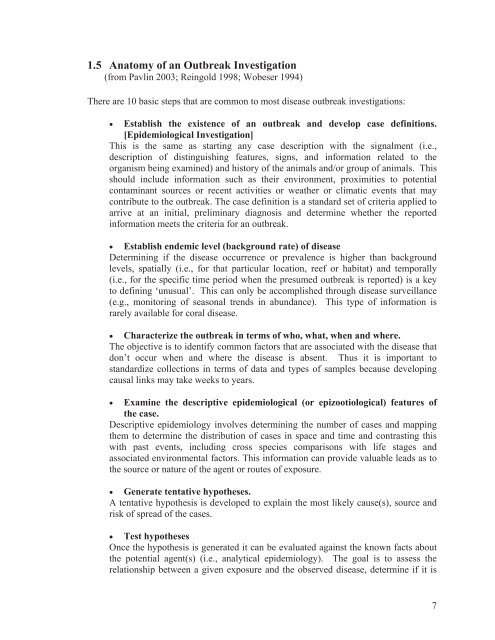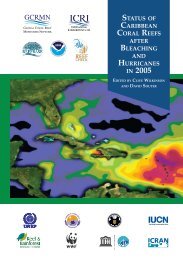Field Manual for the Investigation of Coral Disease Outbreaks
Field Manual for the Investigation of Coral Disease Outbreaks
Field Manual for the Investigation of Coral Disease Outbreaks
Create successful ePaper yourself
Turn your PDF publications into a flip-book with our unique Google optimized e-Paper software.
1.5 Anatomy <strong>of</strong> an Outbreak <strong>Investigation</strong>(from Pavlin 2003; Reingold 1998; Wobeser 1994)There are 10 basic steps that are common to most disease outbreak investigations: Establish <strong>the</strong> existence <strong>of</strong> an outbreak and develop case definitions.[Epidemiological <strong>Investigation</strong>]This is <strong>the</strong> same as starting any case description with <strong>the</strong> signalment (i.e.,description <strong>of</strong> distinguishing features, signs, and in<strong>for</strong>mation related to <strong>the</strong>organism being examined) and history <strong>of</strong> <strong>the</strong> animals and/or group <strong>of</strong> animals. Thisshould include in<strong>for</strong>mation such as <strong>the</strong>ir environment, proximities to potentialcontaminant sources or recent activities or wea<strong>the</strong>r or climatic events that maycontribute to <strong>the</strong> outbreak. The case definition is a standard set <strong>of</strong> criteria applied toarrive at an initial, preliminary diagnosis and determine whe<strong>the</strong>r <strong>the</strong> reportedin<strong>for</strong>mation meets <strong>the</strong> criteria <strong>for</strong> an outbreak. Establish endemic level (background rate) <strong>of</strong> diseaseDetermining if <strong>the</strong> disease occurrence or prevalence is higher than backgroundlevels, spatially (i.e., <strong>for</strong> that particular location, reef or habitat) and temporally(i.e., <strong>for</strong> <strong>the</strong> specific time period when <strong>the</strong> presumed outbreak is reported) is a keyto defining ‘unusual’. This can only be accomplished through disease surveillance(e.g., monitoring <strong>of</strong> seasonal trends in abundance). This type <strong>of</strong> in<strong>for</strong>mation israrely available <strong>for</strong> coral disease. Characterize <strong>the</strong> outbreak in terms <strong>of</strong> who, what, when and where.The objective is to identify common factors that are associated with <strong>the</strong> disease thatdon’t occur when and where <strong>the</strong> disease is absent. Thus it is important tostandardize collections in terms <strong>of</strong> data and types <strong>of</strong> samples because developingcausal links may take weeks to years. Examine <strong>the</strong> descriptive epidemiological (or epizootiological) features <strong>of</strong><strong>the</strong> case.Descriptive epidemiology involves determining <strong>the</strong> number <strong>of</strong> cases and mapping<strong>the</strong>m to determine <strong>the</strong> distribution <strong>of</strong> cases in space and time and contrasting thiswith past events, including cross species comparisons with life stages andassociated environmental factors. This in<strong>for</strong>mation can provide valuable leads as to<strong>the</strong> source or nature <strong>of</strong> <strong>the</strong> agent or routes <strong>of</strong> exposure. Generate tentative hypo<strong>the</strong>ses.A tentative hypo<strong>the</strong>sis is developed to explain <strong>the</strong> most likely cause(s), source andrisk <strong>of</strong> spread <strong>of</strong> <strong>the</strong> cases. Test hypo<strong>the</strong>sesOnce <strong>the</strong> hypo<strong>the</strong>sis is generated it can be evaluated against <strong>the</strong> known facts about<strong>the</strong> potential agent(s) (i.e., analytical epidemiology). The goal is to assess <strong>the</strong>relationship between a given exposure and <strong>the</strong> observed disease, determine if it is7
















